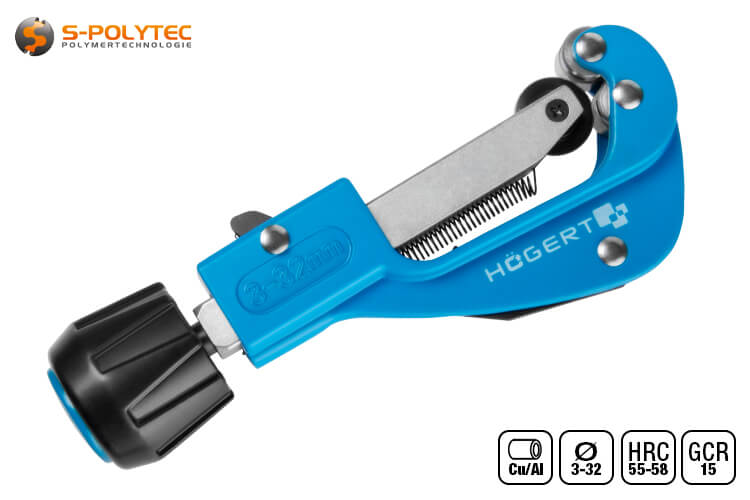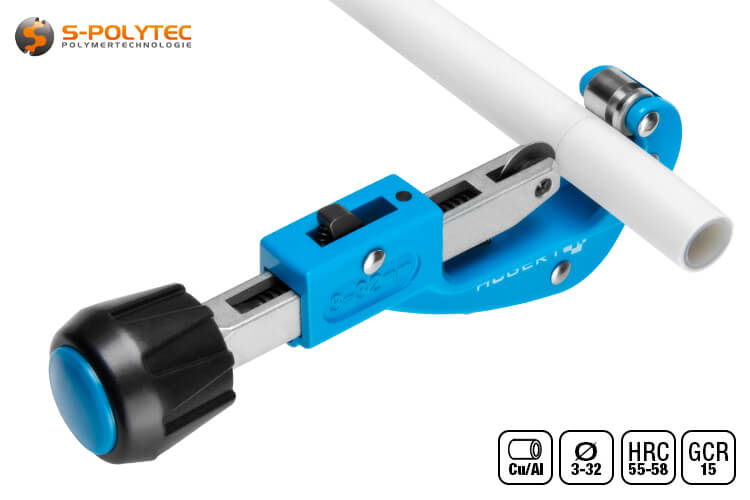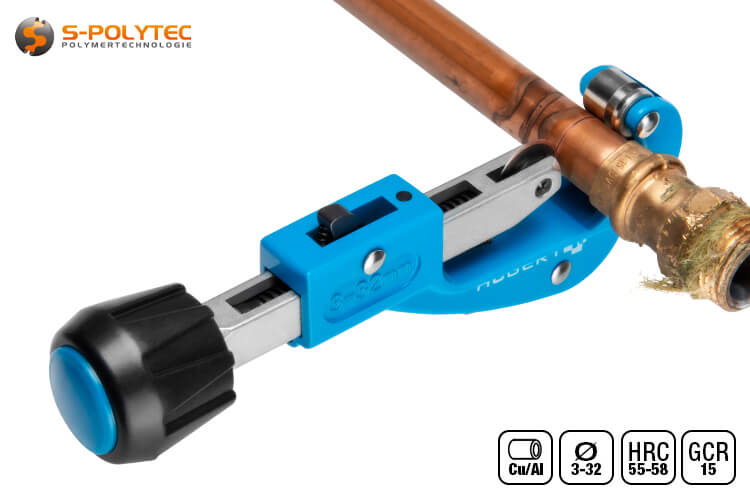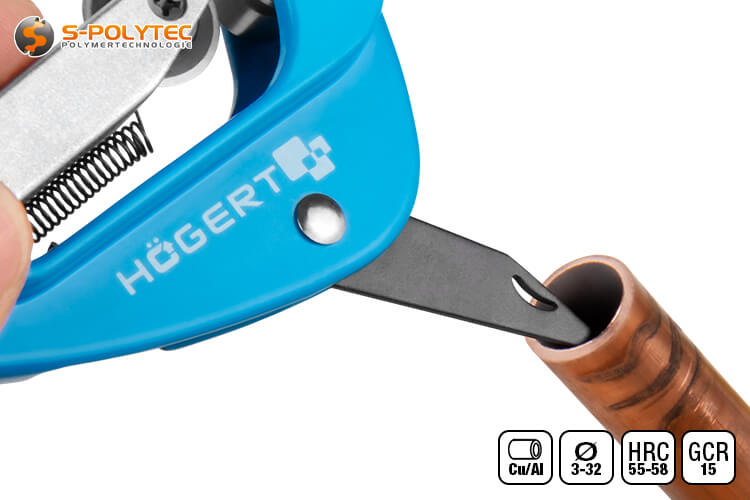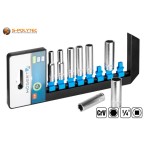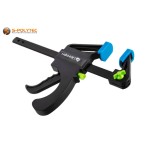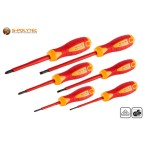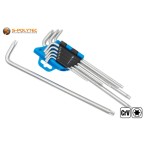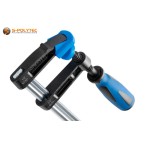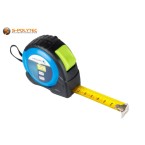
Pipe cutter for aluminium/copper (Ø3 - 32mm)
The Högert pipe cutter with blade made of high-quality alloy steel effortlessly cuts aluminium or copper pipes up to an outer diameter of 32mm and can be placed, operated and opened very easily with one hand.
✓ Alloy steel cutting wheel
✓ Infinitely adjustable from 3mm - 32mm
✓ Large aluminium rotary knob
✓ One-hand quick fixation
✓ Incl. spare cutting wheel
The pipe cutter is ideal for plumbing and heating pipes, as well as cable conduits.
The item is in stock
Dispatch within 2-3 working days
- calculate the price
€12.90 / pc.
0,2720 kg / pc.
All prices include 19% VAT.
- Description
Pipe cutter for aluminium and copper pipes
High-quality cutting wheel ✓ For metal pipes Ø3 - 32mm ✓ With quick fastening ✓
Our pipe cutter from Högert is the ideal tool for precise, largely burr-free cutting of aluminium or copper pipes and is also suitable for multi-layer composite pipes. The compact roller cutter can handle pipes with an outer diameter from 3mm to 32mm. The high-quality cutting wheel is made of very hard alloy steel. The manufacturer also relies on a robust aluminium alloy in solid construction for the housing and the generously dimensioned rotary knob, so that the high demands on quality and service life made by craftsmen and ambitious DIY enthusiasts can be met in full.
The solid guide rollers ensure perfect concentricity of the tool for a perfect cutting pattern. Positioning the blade is child's play and extremely precise thanks to the easy-to-operate one-hand quick release. The button, which can be easily reached with the thumb, is also used to open the clamp fixation of the cut pipe. An integrated deburrer is used to remove any burrs, although these are hardly worth mentioning due to the tension-free cutting method.
Features of the pipe cutter from Högert
The pipe cutter from Högert impresses with its high-quality materials and excellent workmanship to meet the high demands of industry and trade. The housing, as well as the large rotary knob and the powerful spindle holder, are made of solid aluminium. The cutting wheels, guide rollers, as well as the turning spindle and the integrated deburrer are made of alloy steel to ensure maximum service life of the pipe cutting tool. Only the small blue cover cap at the end of the handle, which conceals the spare cutting wheel, is made of robust, impact-resistant plastic.
The wide, solid guide rollers, which are positioned opposite the cutting wheel on the head, contribute to perfect concentricity during the cutting process. These are particularly smooth-running and ensure precise guidance with optimum clamping of the inserted pipe. However, the core element of the pipe cutter is the round cutting wheel with a diameter of just under 18mm. This is made of alloyed GCR15 steel with a very high Rockwell hardness of 55 - 58 HRC. This allows the sharp blade to glide effortlessly through pipes made of a wide range of materials, from pipes made of hard plastic to multi-layer composite pipes, such as aluminium composite pipes, through to pipes made of solid copper, brass or aluminium. In addition to the pre-assembled cutting edge, a further cutting wheel is screwed into the rotary knob, which can be replaced in a few simple steps using a standard Phillips screwdriver. The smooth-running spindle with a coarse thread allows extremely precise and fine adjustment of the cutting wheel in order to work through the pipe piece by piece until it is completely cut through. The comparatively large diameter of the cutting wheel allows pipes with a pipe wall thickness of up to 4mm to be cut. After the cutting process, it may be necessary to deburr the cut edge of the inner pipe wall. However, no additional tools are required for this, as the pipe cutter from Högert is equipped with a deburrer that can be pulled out from the back of the housing, similar to a Swiss army knife.
The pipe cutter can be easily operated with one hand, regardless of whether you are left or right-handed. The quick adjustment function allows you to guide the blade to the workpiece with a simple hand movement and quickly set the correct size of cutter. After the cutting process, the blade is released to the maximum opening position with a single push of a button so that the pipe can be easily removed and the next cut can be made. This saves time and makes the pipe cutter much easier to use. With the spindle fully open, the total length is just 182mm. Seen from the centre of the pipe, the working radius is a maximum of 145mm, so that the pipe cutter can also be used to cut through pipes in the tightest of spaces, where most cutting tools, above all a jigsaw or angle grinder, have a disadvantage. The minimum distance of 20mm from the wall when cutting through masonry is due to the large rotary knob, which contributes to a good grip and effortless adjustment of the cutting wheel thanks to its size. However, the 2cm is also very useful, because if the pipe depth to the wall is too small, it may not be possible to press or solder a fitting onto the pipe.
Advantages of the Högert pipe cutter for aluminium and copper pipes
- The sharp cutting wheel ensures precise, clean separation of pipes
- Thanks to the quick-release lock, the pipe cutter can be released at the touch of a thumb
- The two solid guide rollers guarantee perfect blade concentricity
- The large rotary knob is very easy to use with little effort
- The return spring allows the pipe cutter to be opened quickly at the touch of a button
- The pipe cutter cuts pipes up to Ø 32mm with a pipe wall thickness of up to 4mm
- The pipe cutter is also suitable for cable conduits made of aluminium or PVC
- A replacement blade is hidden in the handle for double the service life
Operating the pipe cutter for metal pipe
As the product name suggests, the conduit cutter is suitable for precise shortening of metal conduits such as aluminium, copper, brass or aluminium composite material, but can also be used for cutting insulation on thick power cables, cutting plastic armoured conduits or aluminium armoured conduits for cable laying. The procedure, which we explain in more detail below, is always almost identical. Only the material hardness has a very small influence on the cutting procedure.
Cutting copper pipe
Cutting copper pipe with a pipe cutter is a very easy task and, in contrast to sawing or abrasive cutting, a very clean, chip-free and extremely precise method of shortening a pipe to the desired size. Provided the desired cutting position has been measured and marked, the cutting wheel can be positioned with an accuracy of a tenth of a millimetre. To do this, open the pipe cutter by pressing the quick-lock button so that it moves to the maximum opening position. The pipe is then positioned between the guide rollers and the cutting wheel and the latter is pushed in with pressure on the knob until the pipe still has a little play between the rollers. The blade is now moved exactly to the marked position and pushed in with a slight further push on the knob until the pipe cutter, or rather its guide rollers and the cutting wheel, achieve a slight clamping and remain in the selected position. If the position is not hit exactly, the cutting wheel can be loosened slightly by turning the knob anti-clockwise to start a new run-up.Once the cutting blade has been positioned, you can start cutting the copper pipe. To do this, move the pipe cutter in a circle around the pipe. This should be repeated with a copper pipe until the pipe cutter glides very easily around the pipe. Only then should the cutting depth of the cutting wheel be increased slightly. An eighth of a turn clockwise is a good guideline here and ensures that both the force required to turn the cutter and the load on the blade are minimised. The pipe cutter is now rolled around the pipe again until the blade no longer encounters resistance and can be turned freely. This process is repeated until the pipe is completely cut through and varies depending on the pipe wall thickness of the heating pipe. The thicker the pipe or the material thickness, the more often the cutting edge has to be adjusted and turned freely. However, the process is so easy that it does not even require manual skill.
The application example for cutting copper pipes can be applied to all metal pipes. However, the pipe cutter is not suitable for pipes made of hard metal such as iron, cast iron, steel or stainless steel, as these metals have a high material hardness that puts too much strain on the cutting wheel and thus massively limits the service life.
TIP: In rare cases, if the clamping of the pipe is too high during cutting, there is high pressure on the thread lock so that the quick release does not allow the cutting wheel to retract. If this is the case, the mechanism is by no means defective. A slight anti-clockwise rotation of the handle releases the locking mechanism slightly so that the cutting wheel springs back into the open position when the release button is pressed at the same time.
Cutting of aluminium composite pipes
Aluminium composite pipes are multi-layer pipes that consist of a thin-walled aluminium pipe at the core, which is coated both inside and out with a mostly white plastic. These pipes can be cut to length very easily with our pipe cutter, provided the outer diameter of the pipe does not exceed the maximum cutting diameter of 32mm. In contrast to solid pipes made of copper, aluminium or brass, the blade of the cutting wheel has much less trouble sliding through the material, so that a quarter turn of the rotary knob can be carried out after about three rounds. The procedure for inserting the pipe, positioning the cutting wheel and opening the pipe cutter is identical. For pipes made of plastic with a higher surface hardness, as is the case with plastic armoured pipes made of rigid PVC, however, a quarter turn may be too much, so that the adjustment of the cutting depth should be adapted from material to material. If in doubt, it is better to adjust less, but more often, so as not to overstress the blade of the cutting wheel.Deburring the cut edges
The pipe cutter is equipped with a simple and effective deburring tool that can be pulled out of the aluminium housing and retracted back into it after use. This is equally suitable for deburring plastic pipes and for removing very fine burrs from copper, aluminium or brass pipes. Due to the functional principle of the roller cutter, the burr is already much smaller when cutting through pipes than with cutting methods such as sawing or abrasive cutting. This wafer-thin burr can be removed very easily by scraping it off with the edge of the deburrer. Ideally, the roller cutter should be held in such a way that the blade of the deburrer is at a steep angle to the cut edge and the inner edge of the pipe is completely removed by turning the pipe. If this is not possible, for example because the pipe is fixed, the roller cutter can also be moved along the edge, which is very easy to do thanks to the very handy, compact design.Other possible applications
A pipe cutter for metal does not necessarily have to be used by plumbers and heating engineers. It also works extremely well when handlebars on bicycles that are too wide need to be shortened precisely to the desired width. The cutter is equally suitable for handlebars made of aluminium or carbon without damaging the material. The same applies to head tubes of bicycle forks or seat posts, even if the latter usually need to be shortened less frequently. Other possible applications include cutting aluminium round tubes in fence construction, cutting cable sheathing for thick electrical cables where a conventional wire stripper is not sufficient or plastic tubes made of transparent acrylic glass, which may well pose the risk of the cut edge cracking when sawing. With the pipe cutter, however, this risk is greatly reduced.Changing the cutting wheel
The pipe cutter has a hardened steel blade that has a very long service life when used correctly. Nevertheless, even the hardest steel will eventually wear out, especially with intensive use. If this is the case and the cutting wheel no longer achieves a sufficient cutting effect in the metal pipe, it can be removed from the guide with a standard Phillips screwdriver and replaced with the replacement blade included in the handle.To do this, use your fingernail to remove the blue plastic cap at the end of the rotary knob and loosen the screw underneath, which also requires a Phillips screwdriver. This loosens the handle and the blade can be removed and inserted into the guide provided for the removed cutting wheel and secured with its screw. Finally, all that remains is to screw the handle to the spindle and press on the blue cover cap.
Note: The cutting wheel is sharp, so make sure you wear suitable protective clothing in the form of cut-resistant work gloves when changing the blade.
Technical data of the Högert pipe cutter
- Product type: Pipe cutter
- Material (Housing): Aluminium
- Material (Rotary knob): Aluminium
- Material (Cutting wheel): Steel (GCR15)
- Degree of hardness (cutting wheel): HRC 55-58 (after Rockwell)
- Cutting wheel diameter: 17,75mm
- Colour: Blue
- Weight: 272 gram
- Functional principle: Roll cutter
- Pipe diameter: 3mm - 32mm (stepless)
- Pipe wall thickness: max. 4,0mm
- Suitable materials:Aluminium, copper, brass, aluminium composite material
- Deburrer: Yes (integrated, extendable)
- Fast return: Yes
- One-handed operation: Yes (on both sides)
- Spare blade: Yes (in the handle)
- Commercial use:Permissible
Care and maintenance of the pipe cutter
The pipe cutter is made from high-quality, rust-free materials, so that each component contributes to a very long service life. However, a certain amount of care and maintenance is essential, even for such a small, simple tool, in order to ensure unrestricted function. The cutting wheel in particular, but also the thread of the spindle, should be cleaned of dirt and coarse impurities at regular intervals. In addition, an occasional drop of oil can maintain the smooth running of the spindle, guide rollers and cutting wheel. To protect the sharp blade from damage caused by knocks and impacts, the cutting tool should always be stored and transported in the tool in the closed end position as follows.
WARNING: When cutting metal pipes with the compact pipe cutter from Högert, protective gloves are recommended to avoid injuries caused by accidental contact with the sharp cutting wheel or the cutting edge of the cut pipes.
- Additional Information
Additional Information
Product-ID CUT01 Delivery Time Dispatch within 2-3 working days EAN/GTIN 5902801239533 Material Aluminium Property Material (cutting wheel): Steel (GCR15) Weight 0.2720 - Reviews
